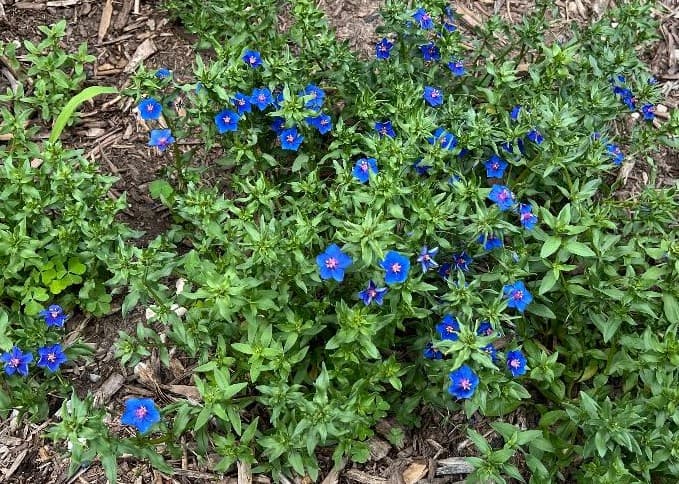How to Grow Poor Man's Weather Glass Flowers

About Growing Poor Man's Weather Glass Plants in Your Home Garden
Poor Man’s Weather Glass plants are easy-to-grow annual flower. As a member of the Primrose family, these plants are native to Europe, and Western and Northern Africa. In Europe, this flower is commonly considered a weed. But, if you are growing Poor Man’s Weather Glass flowers, you recognize it for what it is… a beautiful and attractive flower. The 1/4″ true blue blooms are bright and cheery.
This plant displays an interesting characteristic. It predicts the weather! So, don’t go off to work or the store without checking on to see if the flowers are open or closed. The blooms open on sunny days. They close in cloudy weather if rain is approaching.
Poor Man’s Weather Glass plants grow well in rock gardens, as borders, in cottage gardens, and in containers on your patio or deck. It makes for a good annual ground cover. As an added bonus, these cheerful blue blooms attract butterflies and hummingbirds, too.
Did You Know? Poor Man’s Weather Glass is actually classified as an herb.
Poor Man's Weather Glass Plant Specifications
Flower Colors: Flower colors include blue, pink, red-orange, scarlet, and scarlet red.
Flowers Bloom: Spring through Fall.
Plant Height: Six to seven inches.
Ideal Soil pH: 6.5 – 7.5.
Hardiness Zones: 4a – 8
Light Requirements: Bright, direct sunlight.
Is the Plant Toxic? Yes
Native To: Europe, Western and Northern Africa.
Plant Type: Annual
Botanical Name: Anagallis Monellii
Other Names: Blue Pimpernel, Scarlet Pimpernel, Red Chickweed, Poor Man’s Barometer, Shepherd’s Weather Glass.
Are Poor Man's Weather Glass Plants Edible?
No!!
Touching the plant can cause skin irritation or a rash. Consuming it is poisonous to humans and pets.
Use gloves when working with this plant.
Medicinal Uses for Poor Man's Weather Glass Flowers
There are no known medicinal applications for Poor Man’s Weather Glass Plant.

Light Requirements
Poor Man’s Weather Glass plants grow best in bright, direct sunlight. Give the plant six to eight hours a day of bright, direct sunlight.
The plants will grow in partial sunlight. However, with too little light, the plants grow weaker. And, there will be fewer and smaller flowers.
Plant Propagation
Poor Man’s Weather Glass plants are grown from seeds. They are good re-seeders.
The seeds can be directly sown into your flower garden or seeded indoors for transplanting later. However, they can take a very long time to sprout. So, make sure to clearly mark the planting site.
For indoor starts, sow seeds 4 -6 weeks before the last frost in your area. Or, sow seeds outdoors after all danger of frost has passed. Cover seeds lightly with 1/4″ soil. Water thoroughly once. Then, keep the soil moist, not wet. The seeds germinate slowly.
Note: We recommend a heated germination mat, to increase the speed of germination, and for a higher germination rate.
Transplant young plants into your garden after the last frost date for your area.
Final Plant Spacing: Space them 18 – 24″ apart. They will tolerate a little crowding.
Garden Tip: These plants are not easy to transplant. If started indoors, plant in peat pots. Transplant outdoors when the plants are still young. Plant outdoors, taking care not to disturb the roots.
Poor Man’s Weather Glass are good self-seeders. Select a planting site where you want them to come back year after year.
Days to Germination: 14 to 45 days!

How to Grow Poor Man's Weather Glass Flower Plants
Selecting a Planting Site:
This easy-to-grow plant grows best in full to partial sun. The plants are good re-seeders. So, select a growing location where they can grow for many years.
Soil and Fertilizer Needs:
Poor Man’s Weather Glass flowers grow well in sandy, well-draining soils. Also, they will grow okay in average soils, as they are not heavy feeders. Mixing in a generous amount of compost the first time you plant them will give the new plants a fast start.As a result, these plants do not need a lot of fertilizer. Apply a general-purpose fertilizer every 6-8 weeks.
Water Needs:
Water the plants regularly. But, do not over-water them. Allow the soil to dry out a little between watering.
Promote a Spreading Habit:
Pinch back growing tips in spring and early summer, to encourage the plants to spread. Do not wait too long to do this, as it can delay the blooms.
Add a layer of mulch around the plants when they are young. These spreading plants will quickly fill in empty spaces, making it impossible to add mulch later in the season.
Growing Poor Man's Weather Glass in Flowerpots and Containers
These annuals look absolutely awesome in containers and flowerpots. Locate them on a balcony, deck, patio, or just about anywhere. You can enjoy these cheerful bloomers in a Window box planter outside your window.
Like any container-grown plant, they need a little more care and attention. In addition to normal plant care, here’s how to grow Petunia flowers in containers:
- They look great in a flower grown in masse. The plants tolerate a little overcrowding. So, grow them in containers closer than recommended.
- Select a sunny to partly sunny location on your deck.
- It is important to have a drain hole in the container to allow excess water to drain from the pot.
- Keep an eye on the moisture level. Check the plants every few days, especially in extended periods of hot, dry weather.
- Keep the soil moist, but not wet. It is okay to let the top of the soil begin to dry between watering.
- When watering the plants, thoroughly wet the soil. Excess water will drain through the hole in the bottom of the flowerpot.
- Nutrients in a flowerpot are limited. So, use fertilizer spikes to feed the plants. Or, apply a light solution of liquid fertilizer once a month.
Pruning Poor Man's Weather Glass Plants
These annual plants need little or no pruning. Just remove any dead or damaged leaves and stems. This helps to maintain a neat and tidy appearance.
Remove the blooms as soon as they die off. This promotes additional blooms. And, it extends the blooming period all summer long, and right up to the first killing frost. This will also keep the appearance neat and beautiful.
If you plan on harvesting seeds to grow new plants in a different location, leave a couple of spent blooms on the plant. Then, harvest the seeds several weeks later after they have dried.
More on deadhead spent flower blooms.
Insects and Plant Disease
This plant seldom has problems with insects and disease. If insect or disease problems occur, treat the problem early with organic or chemical insect repellent or fungicide, asw apropriate.
Also see: Plant Problems – Identify the causes and find the cures.
Related Articles
Please support our site. Shop for:
- rmmatthews100@hotmail.com
- 585-721-6528
- Rochester, NY
©1999-2024 GardenersNet.Com, All Rights Reserved

